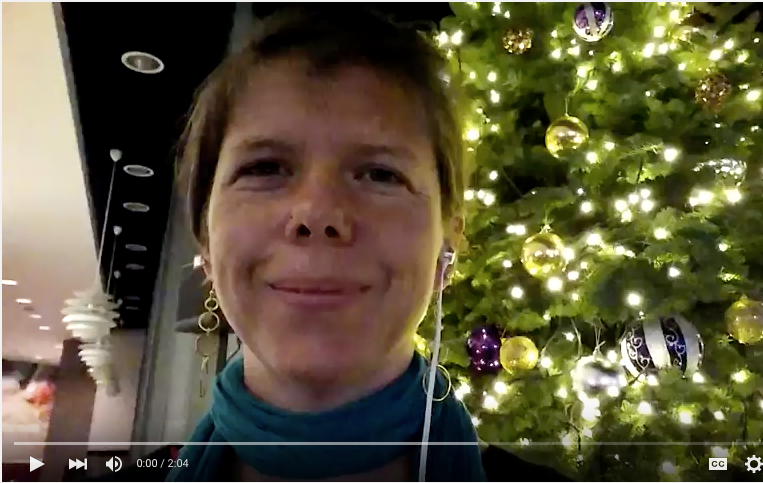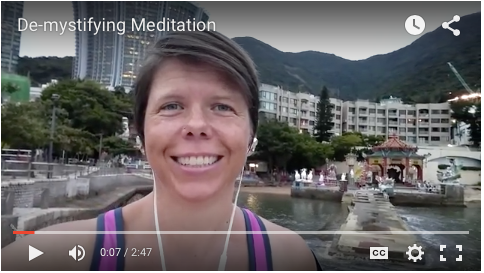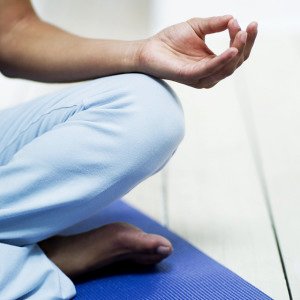
Make your New Year’s resolutions fun! (so you’ll actually do them!)

Make your New Year’s resolutions fun! (so you’ll actually do them!)

Take this simple challenge for the new year : choose a precious time, a time you’d like to savor every day, like dinner with your family, and challenge yourself to take a mindful breath before starting… Every night for the next month!

Many meditators ask this question, “How do I stop thinking?” Luckily for you, you don’t have to stop! Here’s an inspired idea I had for understanding why not… Enjoy!

Many of us have the sense that there is something mysterious about meditation. We may have heard of enlightenment or levitation or other awe inspiring things and think that meditation must be hard to do if it means you will gain all of these things.
Because of this when I make meditation easy for people, sometimes they think, but this can’t be easy! How am I going to get all of these things if meditation is easy?
The secret here is that what is mysterious about meditation isn’t the practice itself, the mystery is you. The practice doesn’t have to be difficult! Practicing meditation can be easy! The mystery is YOU, not the practice.
So don’t make meditation, the practice of it, the techniques, the actual doing of it be difficult. Doing meditation can be easy.
You are a bit more mysterious. The mystery of meditation is getting to know yourself and discovering all that you are. This process can be fun, frustrating, joyful, painful, and all kinds of other things. It happens over time and unfolds uniquely to you.
Enjoy the journey. Enjoy making the practice simple and easy. Enjoy getting to know the mystery of you.

Having a hard time meditating while sitting on the floor with your legs crossed? How can you make it easier?
Simple. Either don’t do it or sit for short amounts of time & build.
Remember that you can meditate in any position, so sitting isn’t necessary. You can do your ‘sitting’ practice while standing, sitting in a chair, lying down, in downward dog, etc.
If you really want to sit on the floor with your legs crossed, start sitting for an amount of time that is comfortable, like 1 or 2 or 5 minutes, do that for awhile to let your body get used to it and then add a bit more time when you feel ready.

Many people suffer from depression or anxiety. Sometimes both.
Two ways to address these issues are physical exercise & mental practices.
By physical exercise I mean good old fashioned walking, running, swimming, tennis, volleyball, etc. Whatever you like to do is best.
By mental practices I mean things that focus your mind on creative, enjoyable or positive things. This could be anything from art to cooking if you love them. To be really sure that you’re focusing on positive things, it can be doubly helpful to engage in things that are designed to be theraputic, because they will have this bias built in. Art therapy, dance therapy, psychotherapy (depending on the therapist), etc.
Interestingly, meditation also helps for the mental focus aspect, because it has the natural outcome of letting your mind rest.
Why are these 2 things important? Because they change the chemical habits that you’ve gotten into. They offer natural a natural way for your mind & body to reset to happy versus sad.

Are you struggling during meditation? Trying to calm your mind and it just isn’t working? Feel like the harder you try the less it works?
This is super frustrating! And pretty normal… I’ve been experiencing this with this in my own practice lately.
The trick with this one is to start with your intention firmly in place, “I intend to quiet my mind.” and then once you start meditating to drop your expectation and just to notice what is happening… notice what ever you mind is doing as you meditate.
Remember that if you’re busy thinking that you want to stop thinking… that you’re actually creating more thought! And what ever your intention is, the magic happens when you take the time to notice whatever is happening and just accept it with out trying to change it. If you let it, it will change on it’s own.
Try it and see how it goes. Feel free to comment below with your experiences or questions.

 I’m standing here meditating because I know it helps me get calm and clear… and my mind is racing.
I’m standing here meditating because I know it helps me get calm and clear… and my mind is racing.
Thoughts and feelings are flying through…
…and, sure enough, here they come, the judgments…
“I can’t believe I’m thinking about missing my appointment yesterday while I’m meditating! This is terrible! I really don’t like feeling this guilt. I wish I would stop feeling like this! I shouldn’t be thinking these awful thoughts. I should be focusing on my breath. Will this ever stop?! This is terrible! I can’t do this!”
We’ve all had this happen!
We’re meditating and we have heard that this will clear our minds of thought. When find ourselves thinking instead, we think, this has got to be bad, right? Clearly, we must be doing it wrong if we’re thinking?
Well, sort of.
The issue here is that if we think that we shouldn’t be thinking then we’re generating MORE thoughts. If we think that we shouldn’t be thinking… then, guess what? We’re thinking! We’re actually adding more thoughts in the mix. If we add anger, guilt or disapproval we feel bad as well. This is the polar opposite of calm and clear. We begin to doubt that we can meditate at all or that it is useful to do.
What’s the secret to getting out of this trap?
The secret is to be kind to yourself.
You’re mind is going to think. That’s it’s job. It’s good at it, and this is a good thing! Enjoy it. Appreciate it. It works hard serving you everything you ask of it.
The thing to realize is that you’re asking it for something new. You’re asking it to slow down and get quiet. It can do that. It will just take some time, some practice. Working with your mind will get you there a lot faster than working against it.
Your mind will naturally quiet if you’re kind to it and allow it to do it’s job with out needing it to be another way right now. If you recognize that it thinks a lot and start from there. If you’re ok with what is true right now and work with that. If you don’t fight it and you’re okay with it, then you allow it to change.
The trick is to keep both things in mind: that you’re intentio n is to be quiet AND that you’re okay with whatever is happening right now (quiet or not)
n is to be quiet AND that you’re okay with whatever is happening right now (quiet or not)
.
Kindness works because as we move towards something, as we accept it, it gives what ever it is the support it needs to change. If we do the opposite, if we deny something and disapprove of it then we don’t give it the support it needs to change. It’s left there hanging, with out any help to do anything different. If I help you change then you will change a lot faster than if I just get mad at you for not changing.
I’m not saying that you have to approve of your thoughts, or feel good about what you’re thinking. I am saying that your mind will be quiet faster if instead of getting upset and demanding that it do something that it isn’t doing, you accept what it is doing and start from there. You can’t lead someone out of a place if you don’t first go to where to they are, take their hand, and guide them out. If you stand somewhere else and get mad at them for being where they are, chances are neither of you is going to go very far, very fast.
Here is a simple formula you can use when you practice:
1. Have the intention of focusing your mind on your practice (on your breath, your body, etc.).
2. Have the intention of being okay (kind) when your mind thinks about everything else instead.
3. Build trust in your practice by noticing after you practice wether you’re calmer and clearer. Don’t monitor how well you’re doing during your practice (which creates more thinking!). Take a moment at the end of your practice to notice how you feel.
Be patient with yourself.
Know that you will get better and better and better at all of this over time.
Remember that you can be kind to yourself when you’re having a tough time being kind. If nothing else, you’re practicing being kind to yourself, which is a pretty cool practice in itself. It feels a lot better than disapproval and like most things with meditation, it tends to overflow into all of the other parts of your life which awesome.
Enjoy,
Elena

 This is one of my favorite questions. In part because meditators really CARE about this.
This is one of my favorite questions. In part because meditators really CARE about this.
Short answer: Yes, there are a lot of them!
Long answer: There are many compelling ideas on every side of this conversation… here are a three different view points to get you started.
I. Sitting Practices: Why you might want to choose a sitting practice…

Sitting practices are more masculine & still. They are great for people who:
II. Moving Practices: Why you might want to dancing or moving practice (i.e. the practice “position” is dance or movement)…
 Moving practices are more fluid, feminine and active. They’re great for people who:
Moving practices are more fluid, feminine and active. They’re great for people who:
III. Portable Practices: Why you might want to choose a practice that allows you to meditate in any position you find yourself in (i.e. every position, including no position is appropriate):

This kind of practice can be very unstructured. It’s great for people who:
As you can see, there are a lot of compelling reasons to adopt any of these systems depending on what kind of person you are and what you’re looking for in your practice.
Whatever you choose, enjoy your practice!
Image License & Credits: Thanks, Spirit-Fire, eviljohnius, Benjamin Chun and Staffan Scherz for the use of your beautiful Creative Commons photos.

Welcome to the Mindfulness Made Easy Portable Practices. In the Mindfulness Made Easy course I teach simple and quick practices that you can do anywhere and anytime.
This is the third portable practice that I teach in the course, Field of Vision. This practice is great for those of you who prefer visual focuses.
It’s your’s to listen to, download and share as many times as you like for personal, non-commercial use. There are written instructions below as well.
Enjoy!,
Elena
To Listen: Click play to listen on this page.
To Download: Click on the Download button below. If it does not download automatically:
Written Instructions: Field of Vision
Note that the first 2 and the last 2 steps are practically the same. We start by becoming present and noticing our breath and end by noticing our breath again. This helps us ground into the present mentally (by simply noticing that I am here, where ever I am, right now) and ground in the present physically, through our bodies (which are by nature in the present).